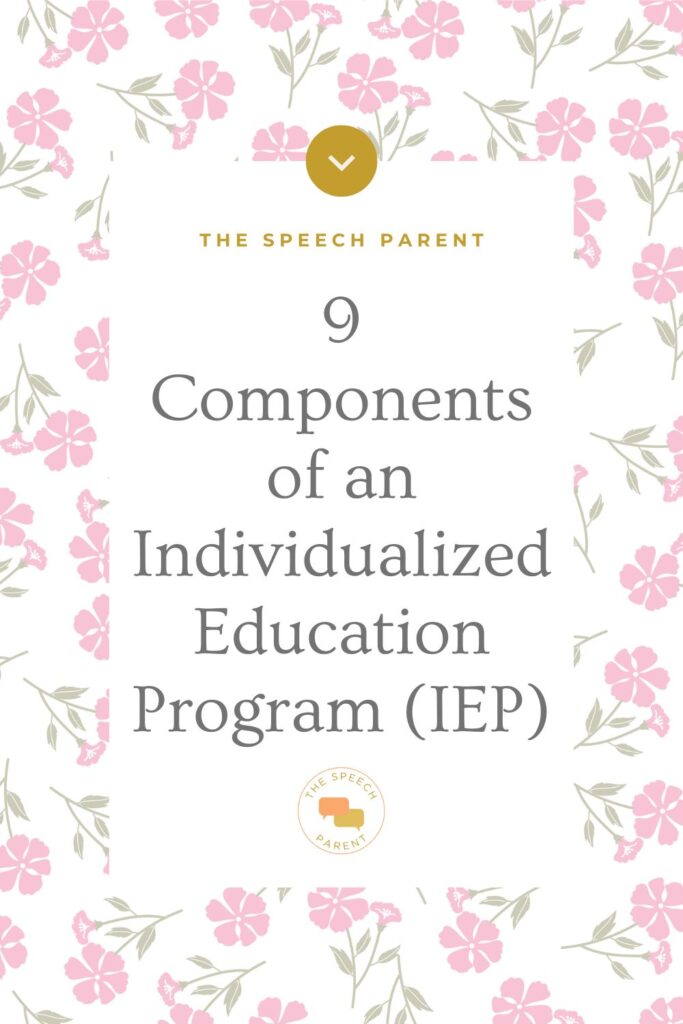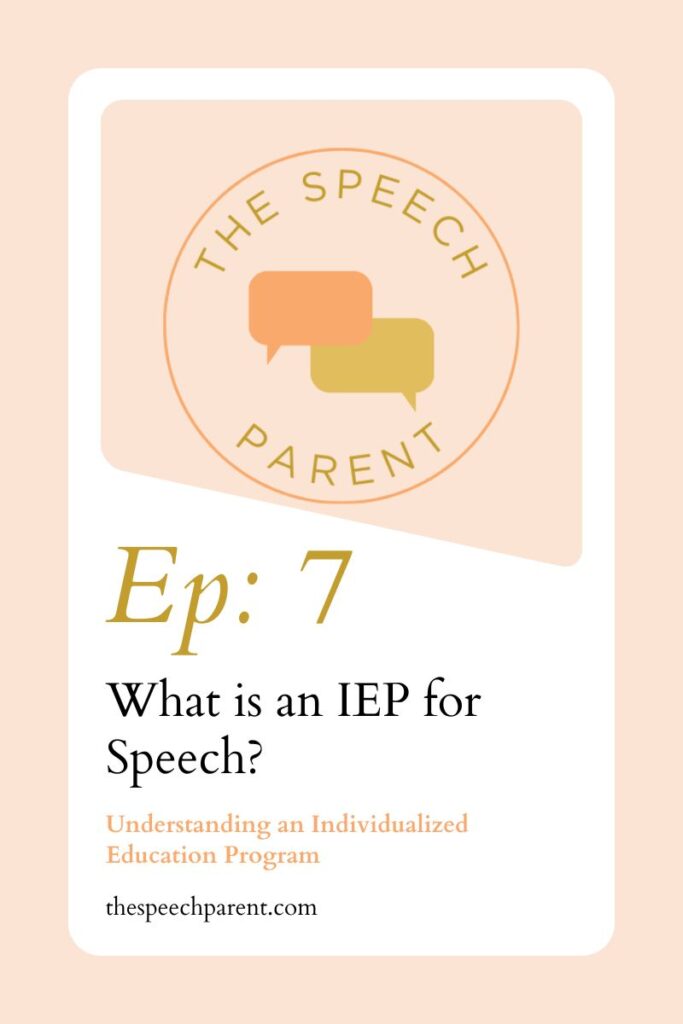Hello hello and welcome back to (reading) the 7th episode of The Speech Parent Podcast. Today we’re answering the question – what is an IEP for speech? I’m so glad you’re here. If you’ve been reading the blogs over the past few weeks, you know that we’ve been discussing the medical model of speech therapy vs the school model of speech therapy (that’s episode 5) and the pros and cons of private speech therapy vs school therapy. So we’re going to continue with the school trend because this is something that will impact most speech parents. So today I’m teaching you all about an Individualized Education Program (or IEP) and answering the question – “What is an IEP for Speech?’
Alright before we dive into today’s post, I want to remind you that you do not have to this parenting thing alone! Parenting is hard, and parenting a child with a speech delay can be even harder. So if you’re looking for some community in your life, maybe you’ve got some questions or just want to make some friends going through the same thing, then please join us in our private Facebook group. You can get the access code by going to thespeechparent.com/community. Alright, let’s dive into answering the question “what is an IEP?” specifically for speech!
What is an IEP?
Okay let’s start by explaining the acronym IEP. It stands for Individualized Education Program. Here’s an official definition for you: “An IEP is a legal document developed for students with disabilities that outlines specific educational goals and the services the school will provide to help meet those goals.”
So what is an IEP? Basically, it’s the plan of what the school system is going to do to help your child. The goal of an IEP is to ensure that a child with a disability receives a free, appropriate public education. This is a right by law in the united states!
So I obviously don’t know your personal circumstances. Maybe your child has another diagnosis besides speech delay so maybe you’re prepared to hear words like ‘disability’. For some people, the word can be jarring. We don’t want to think about something being “wrong” with our baby. And some parents really don’t like the idea of their child getting a speech delay diagnosis or having to have an IEP.
Your Feelings About Your Child Having an IEP are Valid
And this probably isn’t talked about enough so let’s take a minute here. I will never tell you that ANY of your feelings on this journey are not valid. Because they are. Whatever you’re feeling – sadness, frustration, anger, guilt, anxiety, whatever! It is okay to feel however you feel. And you don’t have to change your feelings, but if you want to, then I hope you will keep listening to this episode with an open mind to see that maybe this could be a good thing and maybe it could make you feel more hopeful about the future.
And if not, that’s okay too. Because it’s hard when things don’t go the way we expect. It’s hard when our kids have difficulties – big or small. It’s hard when it feels like our kid is “different”. The unknown is hard. I want you to know that you’re not alone in feeling this way. Your kid may be different than some of the kids at school but there are kids all over the country that deal with the same difficulties as your child. There are speech parents all over this country and this world that face the same emotional rollercoaster as you. The older ones made it through and so will we.
Who Can Have an IEP?
Okay so back to IEPs. So we know that to get one you have to meet disability criteria. The criteria is listed out at a federal level as part of the IDEA which stands for the Individuals with Disabilities Education Act. It’s a federal law, and it explains who qualifies for an IEP. The 5 requirements are:
- Disability category. Your child has to fall into 1 of 13 disability categories. They are:
- Autism
- Deafness
- Deaf-blindness
- Emotional disturbance
- Hearing impairment
- Intellectual disability
- Multiple disabilities
- Orthopedic impairment
- Other health impairment
- Specific learning disability
- Speech or language impairment
- Traumatic brain injury
- Visual impairment
Now how each one of these categories may be determined is fleshed out on a state and local level. So if your child meets criteria for more than one category, the IEP team will decide which category to put as the main qualifying one. Usually it’s the one that they feel has the biggest impact on the child. If you’re a speech parent, then I’m going to assume your child would qualify at least in the Speech or language impairment category.
Other Requirements
Now the second requirement for eligibility is an adverse impact. I’ve mentioned this before, but The disability must adversely affect the child’s educational performance. This means that the child’s ability to learn, progress, or function in the classroom is significantly hindered by their disability.
The third requirement for eligibility of an IEP is the NEED for special education services. (yes, an IEP is under the SPecial education or SPED umbrella) This means that modifications to the general education curriculum or additional supports are necessary for the child to succeed. In the case of a speech delay, we would classify the need fo therapy or accommodations as additional support necessary fo the child to succeed.
The fourth requirement is evaluation. This is obviously how they determine if your child even needs speech therapy or is speech delayed. And then the fifth requirement is parental consent. Your child can not be tested or given an IEP and placed in services without your consent. That is very important! You have so much power as a parent and the decision is ultimately up to you.
So What is an IEP for Speech?
OKAY so recap. What is an IEP? An IEP is the plan that the school system is promising to do to help your child. There are requirements for a child to get one. But once the evaluation is conducted and it is determined that your child meets eligibility criteria, what happens next?
Well that’s when the IEP is created! Creating an IEP is a TEAM process, and as a parent you are a vital part of that team! It is so common for educatio professionals including principals, teachers, speech therapists and whoever to make all of the decisions with the IEP and then just be like “ hey parent are you okay with all of this?” And sometimes it is just that simple. But sometimes it’s not. Sometimes you need to be more involved in the creation process or more vocal with your opinions. Remember that as the child’s parent, you know the child best. Your opinion and voice matter so don’t be afraid to share it.
So the school team may start creating the IEP document and may even send you a copy of it before the meeting to review. Keep in mind that this is a DRAFT copy and changes can still be made. That goes back to you using your voice if needed 🙂
So what is an IEP? Let me break down the components that every IEP should have.
Components of an IEP
- Present Levels of Academic Achievement and Functional Performance (you might hear it called the PLAAFP which is the acronym for it): This is A summary of the child’s current abilities, strengths, and challenges, including how the disability affects their performance in the classroom. It should be really detailed! It kind of explains your child in a big summary.
- Measurable Annual Goals: Specific, measurable goals that the child is expected to achieve within one year. These goals address both academic and functional skills. In the speech world you may see one overarching goal like “improving articulation skills by producing age-appropriate sounds” and then each goal will have different objectives, or short-term goals, that include the specific sounds they’re working on. These break down the annual goals into smaller, manageable steps that help track progress.
- Special Education and Related Services: A description of the specific services the child will receive, including special education, speech therapy, occupational therapy, or any other support services.
- Accommodations and Modifications: Details on any accommodations (e.g., extra time on tests, preferential seating) and modifications (changes to the curriculum) that will be provided to help the child succeed.
- Participation in General Education: An explanation of how much of the school day the child will spend in general education settings versus special education settings.
- Assessment Participation: Information on how the child will participate in state and district-wide assessments, including any necessary accommodations.
- Transition Planning: For older students (typically starting at age 16), a plan outlining goals and services related to transitioning from school to post-secondary education, employment, or independent living.
- Progress Monitoring: A description of how the child’s progress toward meeting the IEP goals will be monitored and reported to parents. (This should happen with each report card!)
- Dates and Duration of Services: Information about when services will begin, how often they will occur, and how long they will last.

As you can see, this is a lot of information! That’s why IEPs are long documents with lots of information! But it’s important that you as a parent understand it. So if you’re not sure, please ask questions! If you want an outsider to look at it or have questions for me as a speech therapist and speech parent, then send me a dm on social media (@thespeechparent) or email me at thespeechparent@gmail.com. I’ve also got one-on-one coaching that I offer via Zoom, and I’ll share the link in the show notes but it’s thespeechparent.com/coaching
Remember, What You Think Matters!
So yes it’s important that you understand each component of the IEP and feel comfortable with it. Like do you think that’s enough accommodations for your child to help him or her succeed? Are you okay with them being out of the classroom for X amount of minutes? These are the services and supports tjat they are having for probably an entire year (unless you do an amendment) so make sure you feel comfortable with it all!
And if you all get started and part way through the year you all realize that something isn’t working and needs to change, don’t be afraid to ask for an amendment! You can change an IEP with another conference. It can feel like a big ordeal to make a small change, but if it’s important then don’t be afraid to ask for that meeting. No one will advocate for your child like you!
Okay so I hope this blog post was helpful for you to learn all about what is an IEP. Let me know what questions you have or what you want to learn more about by sending me a dm on instagram @thespeechparent. And please consider sharing with another speech parent friend so that we can get the word out and help as many speech parents as possible. They may be wondering what is an IEP as well! I’m so thankful for you guys and it means the world to me that a *handful* of you listen each week so thank you thank you. I’m so glad you’re here, and don’t forget that the best is yet to come.
